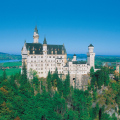The enchanting castle of King Louis II: an enchanting setting that has fed the imagination of romantics for nearly 150 years.
You can already see it from afar: white, like the swan and like the mountain that surrounds it, with its turrets and completely innovative style - simply splendid! Neuschwanstein Castle was built between 1869 and 1886. When Ludwig II began building it, he decided to make all his wildest dreams come true. He wanted it to be a sacred, inaccessible and protective high place, his earthly refuge of sorts. He also wanted it to belong to him and him alone. So he ordered that, on his death, the château should be destroyed so that it would not be exposed to the profane gaze. Ludwig II's greatest regret was that Richard Wagner was never able to bring his palace to life with his music. Work on the castle was never completed. By 1886, the year of Ludwig II's death, only a third of the rooms had been completed. The Munich architects Dollmann and Riedel were entrusted with the realization of this crazy dream. Neuschwanstein's plans were inspired by medieval fortresses, with a gateway, keep, royal dwelling and more. Today, Neuschwanstein Castle is one of the most visited sites in Germany, attracting over 1.5 million tourists a year.
Once inside, the enchantment begins. What a contrast to the sober, white exterior! In fact, everything here is colorful, harmonious and ornate. Only the3rd and4th floors can be visited. The third floor features a trapezoidal entrance hall with a vaulted ceiling. The floor is covered with a superb mosaic made up of over 2 million pieces representing the animal and plant kingdoms. Entirely dedicated to the work of Wagner, the castle is brimming with allusions to the work of the great composer Richard Wagner. The frescoes in the dining room and study depict the legend of Tannhäuser, the paintings in the king's bedroom are a tribute to Tristan and Isolde, while the grand salon immortalizes the epic of Lohengrin, the swan knight. Wagner is omnipresent in all this gilded splendor. The highlight of the visit is the throne room, a tribute to Parsifal with its trompe-l'œil painting of a forest behind the vaults. The room is marble, the floor is mosaic and the atmosphere is Byzantine, with palm trees painted on the walls. Don't look for a throne in the throne room, as it was never built. The boudoir, with its artificial grotto and stalactites, is a veritable opera set, a touch kitsch but pleasant. On the upper floor is the Singers' Hall, whose style is borrowed from the Wartburg in Eisenach, a fortress that fascinated Ludwig II, a lover of medieval architecture. The tour ends with the kitchens, where the construction work was completed... Before exiting, a balcony offers a phenomenal view of Lake Alpsee and Hohenschwangau Castle below.
If your budget doesn't allow you to visit both castles, you're welcome to visit Neuschwanstein, whose interior decoration is even richer than that of Hohenschwangau... The castle's rooms are currently being renovated, but remain open to the public. It's worth pointing out that it's not possible to take photos inside the castle, and that the tour is a little rushed.
Did you know? This review was written by our professional authors.
Members' reviews on NEUSCHWANSTEIN CASTLE
The ratings and reviews below reflect the subjective opinions of members and not the opinion of The Little Witty.













Some rooms are downright unforgettable, the bedroom with its incredible Gothic bed, the throne room, without throne because it did not have time to complete this castle.
However, it is the large flat, tours can be done only by groups and the schedules are very tight. Too bad